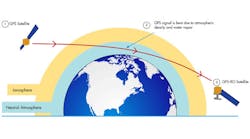A newly introduced weather instrument uses next-generation sensor technology to penetrate through clouds and storms, produce the highly calibrated data required to improve weather forecasting, climate monitoring, and space weather prediction. The Pyxis instrument from PlanetiQ tracks GPS signals traveling through Earth’s atmosphere, concerting them into dense, precise measurements of global temperature, pressure, and water vapor.
This is accomplished through a technique called GPS Radio Occultation (GPS-RO)—one that is similar to how data is collected via weather balloons, but on a global scale. Pyxis is reportedly the only GPS-RO sensor in such a small package that is powerful enough to routinely probe down into the lowest layers of the atmosphere where the most severe weather occurs. It also is capable of tracking signals from the four most major satellite navigation systems: GPS, Galileo, Beidou, and GLONASS.
PlanetiQ’s impending microsatellite constellation—an initial set of 12 will launch in 2016 and 2017—is set to deliver more than eight million observations per day of temperature, pressure, and water vapor. This will provide approximately 10 times the amount of data available from currently on-orbit GPS-RO sensors. GPS-RO, specifically, has shown the highest impact per observation on forecast accuracy, making it particularly effective at improving predictions of high-impact weather.

